枣(Ziziphus jujuba Mill.)是鼠李科枣属植物,是中国的传统果树之一。枣树对土壤适应性强、耐贫瘠和盐碱、管理简约,是经济和生态两用型果树。目前,市场畅销品种相较单一,而消费者对食品的健康和多样性需求增加,因此加速枣树品种改良和新品种选育尤为重要[1-2]。枣实生选种成本低,操作简单,可以在较短的时间内获得大量的后代,为育种提供高效途径[3]。良好的果实品质直接影响经济价值,了解果实品质等性状的遗传规律,筛选优异种质资源,对枣品种的遗传改良和新品种选育极有意义。
果实性状一直是科技工作者研究的重点之一。对果实性状的遗传规律进行研究,有利于优异种质资源的筛选。枣树因花小、去雄困难、坐果率低等特点,传统的杂交育种存在一定的限制[4-6]。在自然授粉的前提下,利用收集到的母本种子,通过实生的方式对其实生后代果实主要的性状进行综合评定,成为了枣树育种的主要途径之一[7-9]。目前,对果实品质和糖酸组分含量进行研究,发现后代果实性状存在广泛分离[10-14]。以多个枣的实生后代为材料进行研究发现,在多亲本的影响下,后代群体数量性状出现较为丰富的变异[15-17]。优良品种的实生后代群体的单果质量均存在广泛分离,果实糖酸含量变异幅度也较大,有利于高糖、高酸单株的筛选[18]。当前实生后代枣果实性状研究集中在果实大小、糖酸含量等方面,对不同枣品种实生后代在果实品质、成熟期、果核、丰产性及抗性等性状的系统性和全面性变异研究还有待加强。因此笔者在本研究中以冬枣、雨虹两个品种的实生后代及其亲本为材料,对果实主要性状进行变异研究,解析不同枣品种实生后代分离变异特征,筛选出特异性较高的优株,并通过综合评价筛选出综合性状突出的优株,旨在丰富枣种质资源,为新品种选育提供理论参考依据。
1 材料和方法
1.1 试验材料
2016年于第一师十团苗木中心试验基地,采用隔离罩网控制蜜蜂杂交方式,2017年将取得的种仁基质播种育苗,定植于塔里木大学园艺试验站4 号温室,2021 年春季采集长势健壮实生接穗,嫁接于12团试验基地,砧木为6年生灰枣树,株行距为1 m×2 m,正常田间管理。2023年对结果性状稳定的112株实生后代进行调查,其中冬枣实生后代76 株、雨虹实生后代36株。
1.2 果实成熟期调查
成熟期:按照全红期的采样时间,确定果实成熟的时间,在9月上旬、9月中旬、9月下旬、10月上旬、10月中旬、10月下旬采样并进行分类。
1.3 果实丰产性及抗性调查
丰产性、裂果率的等级根据《中国枣种质资源》[19]、段开行等[20]的依据进行划分。
1.4 果实性状的测定
果实外观品质:依据《中国枣种质资源》[19]、《枣种质资源描述规范和数据标准》[21],按照标准对果实描述型性状进行观察和品尝,并实时进行拍照记录,作为参考依据。
单果质量、果实纵横径:选取30 个发育正常的枣,用电子天平测定单果质量,单位:g,精确到0.01 g,用游标卡尺测定果实纵横径,单位:mm,精确到两位小数点。果形指数:果形指数=果实纵径/果实横径。
果核质量:与单果质量的材料一致,将枣的果肉剔除后,刷干净后晾干用电子天平测定,取平均值,单位:g,精确到0.01 g。
果核指数=果核纵径/果核横径。
可食率/%=(单果质量-果核质量)/单果质量×100。
果实营养品质:可溶性固形物含量采用便捷式可溶性固形物测定仪测定,可溶性糖含量采用蒽酮比色法[22]测定;可滴定酸含量采用酸碱中和法[22]测定;维生素C 含量采用钼酸铵比色法[23]测定。可溶性蛋白含量采用[22]考马斯亮蓝G-250 测定,黄酮含量[24]采用硝酸铝-亚硝酸钠比色法测定,总酚含量[24]采用福林酚试剂法测定。
1.5 优异种质资源评价筛选方法
利用灰色关联度中的加权关联法和等权关联法,10 人小组按照鲜食枣综合评价标准,对两个枣品种实生后代群体进行综合评价,按照制干枣综合评价标准[25-26]对雨虹实生后代进行综合评价,筛选出优异的鲜食枣种质资源和制干性能优异的种质资源,同时按照董玉慧[27]的评价标准进行特异性种质资源的筛选,其中综合口感按照表1进行赋分,制干性能按照表2进行赋分。
表1 综合口感赋分
Table 1 Comprehensive taste score

性状Traits果肉质地Pulp texture果肉汁液Pulp juice果皮厚度Pericarp thickness果肉粗细Flesh thickness权重值Weight value 30致密:0 Porosity:0 30 20 20评分值Score value酥脆:30 Densification:30多:30 Poly:30薄:20 Thin:20细:20 Coarse:20疏松:10 More compact:10中:15 Mid:15中:10 Mid:10中:10 Mid:10较致密:5 Crisp:5少:0 Hypo:0厚:0 Thickness:0粗:0 Tenuity:0
表2 制干性能赋分
Table 2 Drying performance assignment
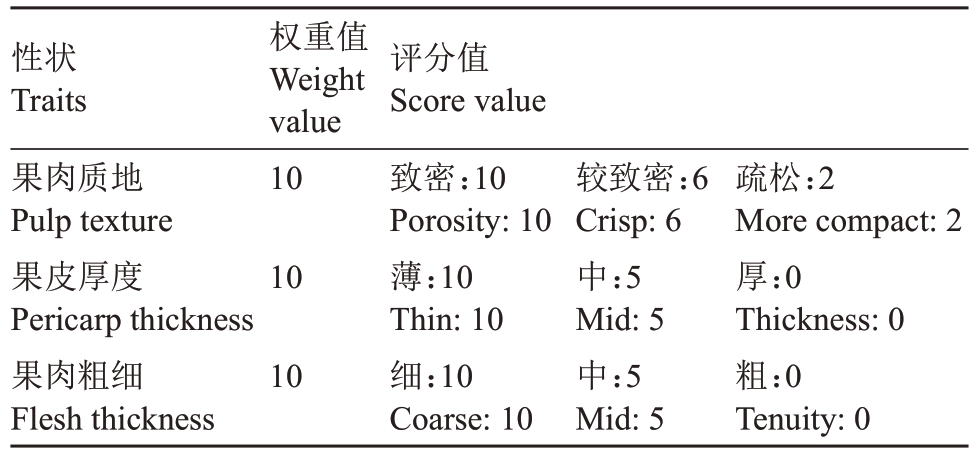
性状Traits果肉质地Pulp texture果皮厚度Pericarp thickness果肉粗细Flesh thickness权重值Weight value 10 10 10评分值Score value致密:10 Porosity:10薄:10 Thin:10细:10 Coarse:10较致密:6 Crisp:6中:5 Mid:5中:5 Mid:5疏松:2 More compact:2厚:0 Thickness:0粗:0 Tenuity:0
1.6 数据分析
利用Excle 2019和SPSS 26.0对所有花、果数据进行处理,计算其平均值、标准偏差、最小值、最大值、极差、变异系数、偏度和峰度等描述型参数,分析其遗传变异规律。用Origin 2018绘图。
2 结果与分析
2.1 枣实生后代果实描述型性状的变异分析
2.1.1 果实形状及颜色性状分离情况 枣实生后代果实形状及颜色分离情况如表3 所示,果实形状共分离出8种类型,分离广泛。冬枣后代果实形状为7种表型,分离范围最广,扁圆形后代最多,占比为40.79%;其次为长圆形的后代,占比为30.26%。雨虹后代果形为6种表型,其中长圆形的后代最多,占比为38.09%;其次为母本形状的圆锥形后代,占比为27.78%。果实颜色共分离出4 种类型,两个枣品种实生后代群体均以与母本果实颜色一致的红色后代最多,其中冬枣后代占比为85.53%、雨虹后代占比为91.67%。
表3 果实形状及颜色频率分布情况
Table 3 Fruit shape and color frequency distribution
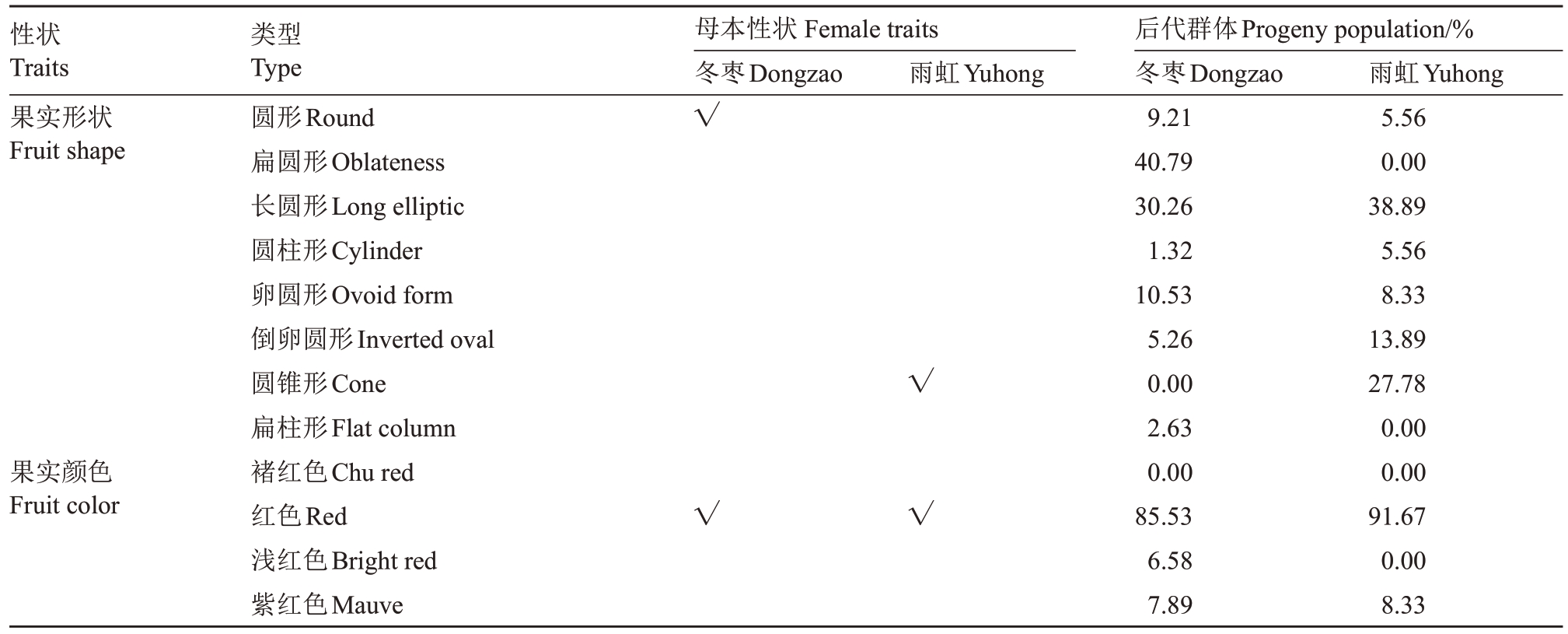
注:“√”代表母本的对应性状。下同。
Note:‘√’represents the corresponding trait of the female parent.The same below.
性状Traits果实形状Fruit shape母本性状Female traits冬枣Dongzao√类型Type圆形Round扁圆形Oblateness长圆形Long elliptic圆柱形Cylinder卵圆形Ovoid form倒卵圆形Inverted oval圆锥形Cone扁柱形Flat column褚红色Chu red红色Red浅红色Bright red紫红色Mauve雨虹Yuhong 5.56 0.00 38.89 5.56 8.33 13.89 27.78 0.00 0.00 91.67 0.00 8.33雨虹Yuhong√果实颜色Fruit color √√后代群体Progeny population/%冬枣Dongzao 9.21 40.79 30.26 1.32 10.53 5.26 0.00 2.63 0.00 85.53 6.58 7.89
2.1.2 果实感官性状分离情况 枣实生后代果实果肉性状的分离情况如表4 所示,6 个性状分离出21种类型,分离广泛。两个枣品种实生后代群体均有40%以上的后代果实风味表现为甜,且与母本性状表现一致。冬枣后代薄果皮占39.47%,果肉酥脆占57.89%,汁液中占47.37%,除果肉汁液外,其余性状均与母本表现一致的后代较多。雨虹后代中有47.22%的后代果皮厚,果肉较致密,果肉汁液少,果肉颜色浅绿色,果肉粗细中等,其中果肉质地、果肉粗细、果肉颜色、果实风味与母本性状表现一致的后代较多。
表4 果实感官性状的频率分布情况
Table 4 The frequency distribution of flesh traits
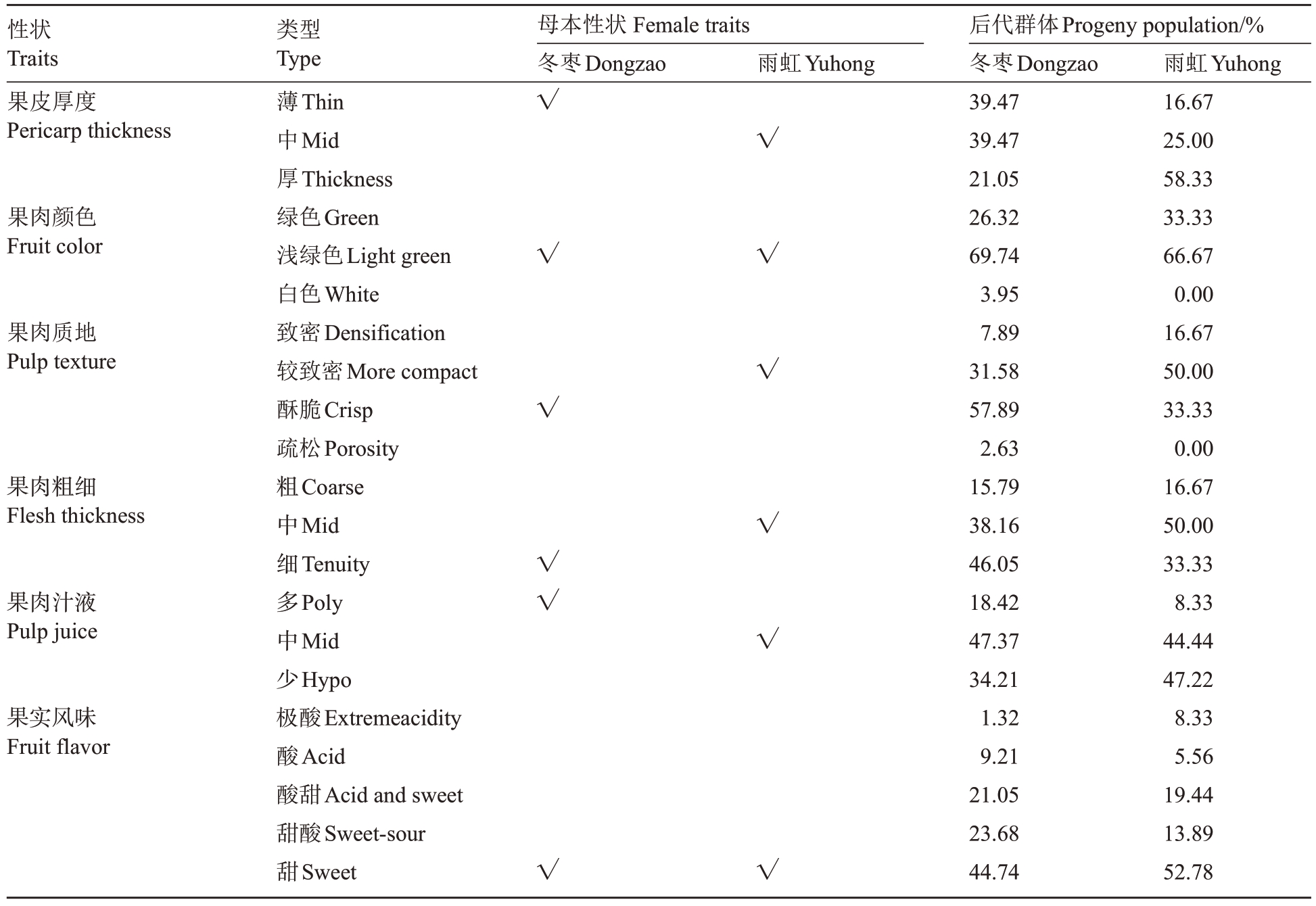
性状Traits果皮厚度Pericarp thickness母本性状Female traits冬枣Dongzao√类型Type薄Thin中Mid厚Thickness绿色Green浅绿色Light green白色White致密Densification较致密More compact酥脆Crisp疏松Porosity粗Coarse中Mid细Tenuity多Poly中Mid少Hypo极酸Extremeacidity酸Acid酸甜Acid and sweet甜酸Sweet-sour甜Sweet雨虹Yuhong√果肉颜色Fruit color √√果肉质地Pulp texture √√果肉粗细Flesh thickness √果肉汁液Pulp juice√√√果实风味Fruit flavor√√后代群体Progeny population/%冬枣Dongzao 39.47 39.47 21.05 26.32 69.74 3.95 7.89 31.58 57.89 2.63 15.79 38.16 46.05 18.42 47.37 34.21 1.32 9.21 21.05 23.68 44.74雨虹Yuhong 16.67 25.00 58.33 33.33 66.67 0.00 16.67 50.00 33.33 0.00 16.67 50.00 33.33 8.33 44.44 47.22 8.33 5.56 19.44 13.89 52.78
2.2 果实大小性状及可食率的遗传变异分析
2.2.1 果实大小性状及可食率的分离情况 枣实生后代果实大小性状及可食率分离情况如表5 所示,果实大小性状及可食率分离广泛,其变异系数范围为1.73%~57.49%,其中均以冬枣单果质量的变异系数最大,存在较为广泛的分离,有利于大小果型资源的筛选。可食率变异系数最小,均在1.93%以下,表明可食率的遗传较为稳定,其中冬枣可食率超母本的占31.58%,单果质量和果实横径最大值均出现在冬枣实生后代中,分别高出母本冬枣19.34 g和11.48 mm,且冬枣后代单果质量和果实横径平均值均高于雨虹实生后代群体,表明冬枣实生后代中出现大果资源的潜能相对较高。
表5 枣实生后代果实大小及可食率的分离情况
Table 5 Separation of fruit size and edible rate of jujube seedling offspring

后代群体Progeny population冬枣Dongzao雨虹Yuhong性状Traits单果质量Single fruit mass/g果实纵径Fruit length/mm果实横径Fruit diam/mm果形指数Fruit shape index可食率Edible rate/%单果质量Single fruit mass/g果实纵径Fruit length/mm果实横径Fruit diam/mm果形指数Fruit shape index可食率Edible rate/%母本值FPV 10.91 26.01 26.65 0.98 97.66 11.11 33.78 24.44 1.38 97.69超母本占比UMP/%34.21 42.11 38.16 63.16 31.58 8.33 16.67 16.67 55.57 27.78平均值Mean 10.26 26.00 25.33 1.03 96.89 7.34 29.72 21.04 1.41 96.73标准差SD 5.90 5.83 5.09 0.13 1.87 3.00 5.83 3.22 0.17 1.67最小值Min.2.11 15.40 15.15 0.82 86.65 1.66 15.77 13.00 1.07 88.98最大值Max.30.25 42.03 38.13 1.38 98.81 14.78 41.83 27.05 1.94 98.48极差Range 28.14 26.63 22.98 0.56 12.16 13.12 26.06 14.05 0.87 9.50变异系数CV/%57.49 22.42 20.09 12.49 1.93 40.93 19.62 15.29 12.15 1.73
2.2.2 果实大小性状的遗传分布情况 对两个品种实生群体果实大小性状和可食率进行正态性检验(图1),冬枣、雨虹实生后代的果实纵径和果实横径均符合正态分布,果形指数、可食率不符合正态分布。其中冬枣后代的单果质量正态拟合曲线上侧尾部较长,单果质量数值点多集中在下侧,说明冬枣后代的单果质量偏小居多。冬枣和雨虹后代可食率相差不大,但冬枣后代的单果质量出现极大果远多于雨虹后代,这表明冬枣后代更具备大果型种质的创制潜能。在冬枣后代中果形指数多集中于1.0附近,说明冬枣后代扁圆形居多。
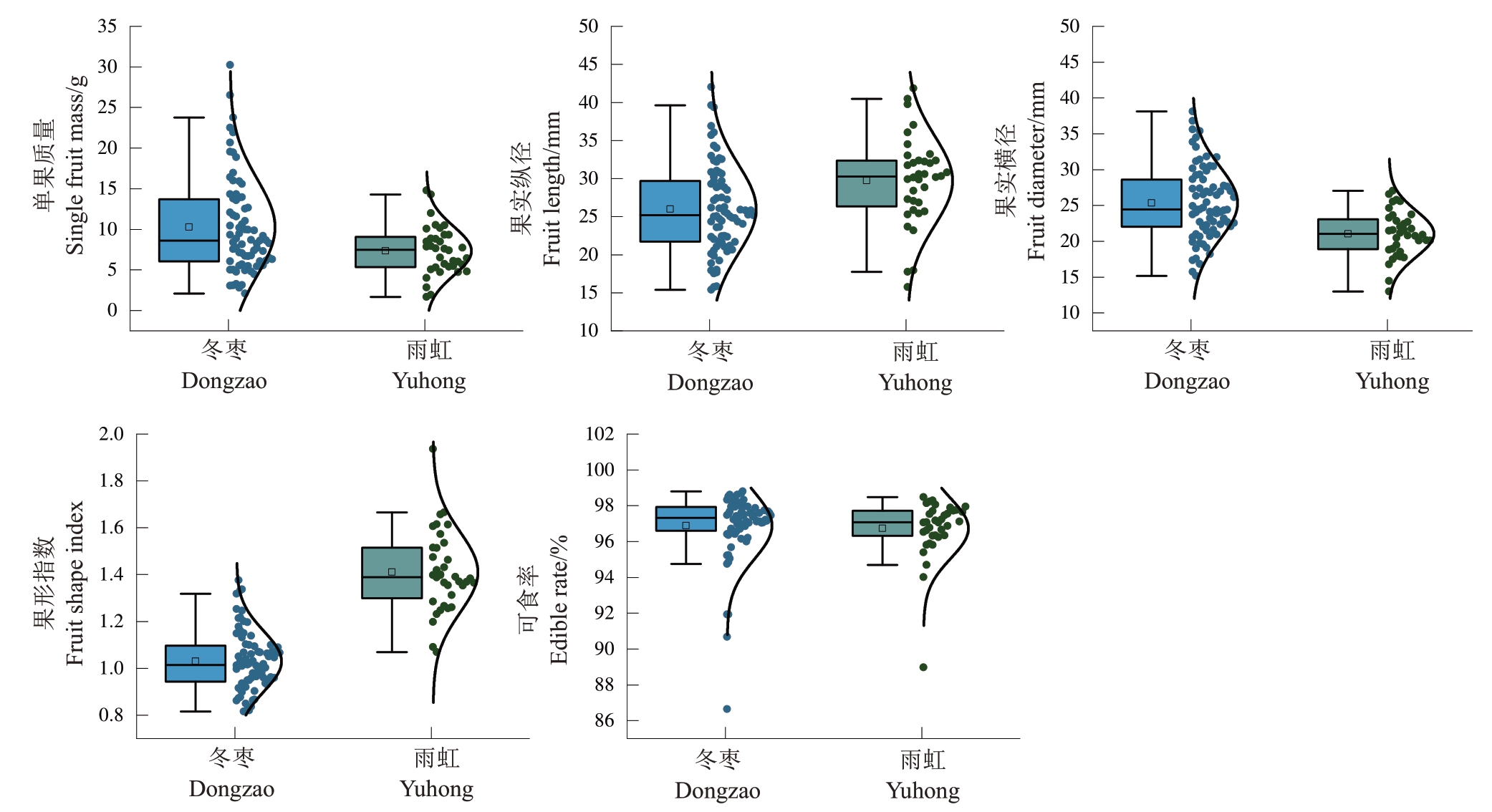
图1 果实大小及可食率性状的遗传分布
Fig.1 Genetic distribution of fruit size and edible rate traits
2.3 果实营养品质性状的变异分析
2.3.1 果实营养品质性状的分离情况 枣实生后代果实内在品质的分离情况如表6 所示,两个枣群体实生后代的内在品质性状均存在较为广泛的分离,其变异系数范围在7.51%~64.72%之间。两个枣实生后代中可溶性固形物含量变异幅度高达7.79%,且出现超亲现象,有利于高可溶性固形物含量资源的筛选。可溶性糖含量变异幅度高达16.42%,存在广泛分离,冬枣、雨虹后代中可溶性糖含量出现的最高极端值均在31.73%以上,有利于高糖资源的筛选。可滴定酸含量变异系数均在47.86%以上,大于母本的个数均在66.67%以上,其平均值也均高于母本,出现超亲现象,有利于高酸资源的筛选。维生素C 含量的变异系数均在23.50%以上,其最高变异幅度达到754.27 mg·100 g-1,存在较为广泛的分离,冬枣维生素C含量大于母本的占比达到了100%,拥有筛选高维生素C含量种质资源的优势。黄酮含量的变异系数均在50.62%以上,分离广泛;冬枣后代总酚含量超过母本的后代占比85.53%以上,存在超亲现象。蛋白质含量在后代中出现超亲占比在19.44%以上。
表6 枣实生后代果实营养品质的分离情况
Table 6 Jujube seedling progeny fruit nutrition quality separation situation
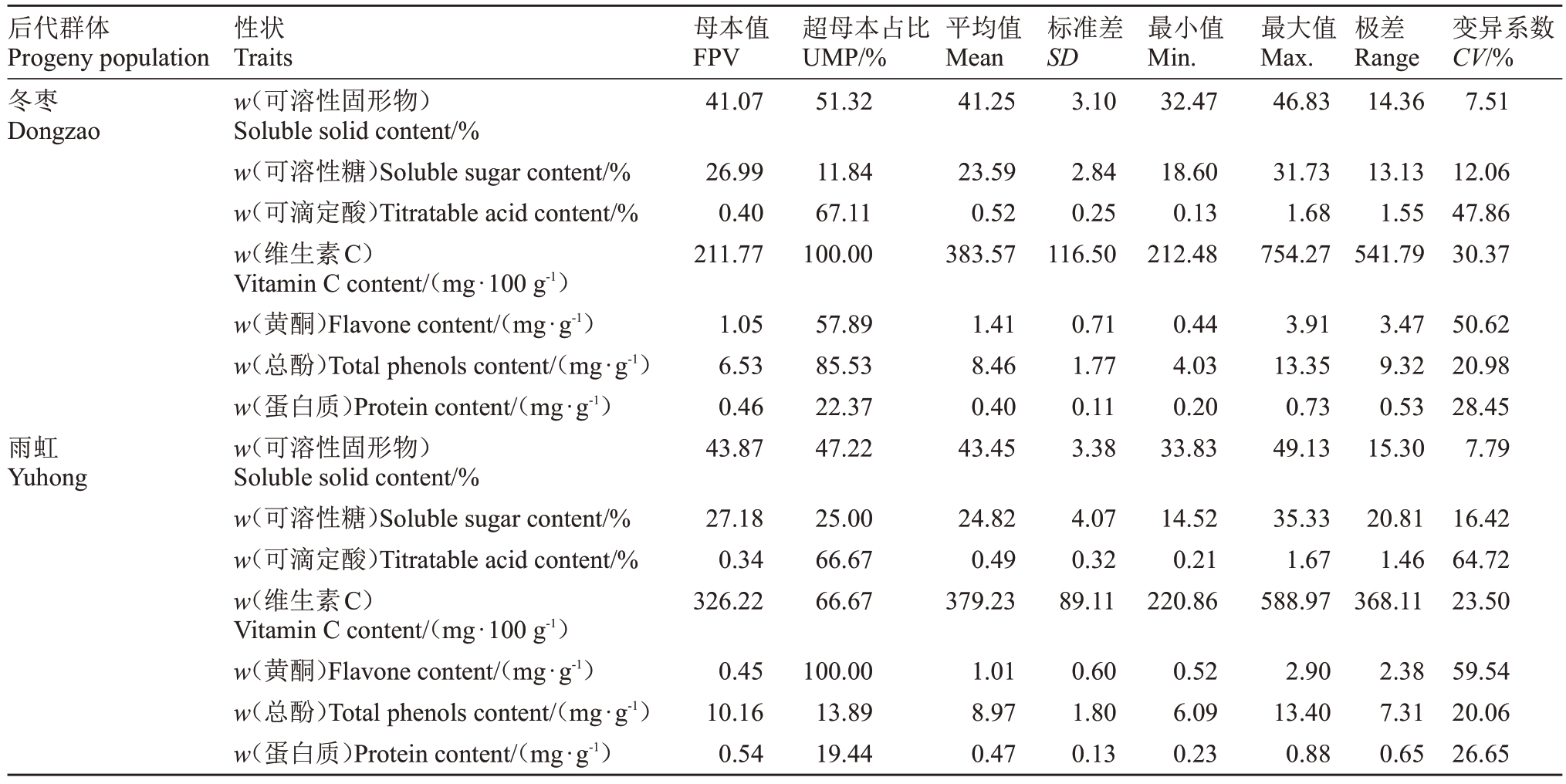
后代群体Progeny population冬枣Dongzao母本值FPV 41.07 26.99 0.40 211.77超母本占比UMP/%51.32 11.84 67.11 100.00平均值Mean 41.25 23.59 0.52 383.57标准差SD 3.10 2.84 0.25 116.50最小值Min.32.47 18.60 0.13 212.48最大值Max.46.83 31.73 1.68 754.27极差Range 14.36 13.13 1.55 541.79变异系数CV/%7.51 12.06 47.86 30.37雨虹Yuhong性状Traits w(可溶性固形物)Soluble solid content/%w(可溶性糖)Soluble sugar content/%w(可滴定酸)Titratable acid content/%w(维生素C)Vitamin C content/(mg·100 g-1)w(黄酮)Flavone content/(mg·g-1)w(总酚)Total phenols content/(mg·g-1)w(蛋白质)Protein content/(mg·g-1)w(可溶性固形物)Soluble solid content/%w(可溶性糖)Soluble sugar content/%w(可滴定酸)Titratable acid content/%w(维生素C)Vitamin C content/(mg·100 g-1)w(黄酮)Flavone content/(mg·g-1)w(总酚)Total phenols content/(mg·g-1)w(蛋白质)Protein content/(mg·g-1)1.05 6.53 0.46 43.87 57.89 85.53 22.37 47.22 1.41 8.46 0.40 43.45 0.71 1.77 0.11 3.38 0.44 4.03 0.20 33.83 3.91 13.35 0.73 49.13 3.47 9.32 0.53 15.30 50.62 20.98 28.45 7.79 27.18 0.34 326.22 25.00 66.67 66.67 24.82 0.49 379.23 4.07 0.32 89.11 14.52 0.21 220.86 35.33 1.67 588.97 20.81 1.46 368.11 16.42 64.72 23.50 0.45 10.16 0.54 100.00 13.89 19.44 1.01 8.97 0.47 0.60 1.80 0.13 0.52 6.09 0.23 2.90 13.40 0.88 2.38 7.31 0.65 59.54 20.06 26.65
2.3.2 果实营养品质性状的遗传分布情况 对两个群体内在品质性状进行正态性检验,结果(图2)表明冬枣、雨虹实生后代可溶性糖含量、总酚含量均符合正态分布,维生素C 含量、可滴定酸含量、黄酮含量不符合正态分布。雨虹后代可溶性固形物含量的正态拟合曲线下侧较长,数量点多集中在上侧,表明后代可溶性固形物含量较大的后代较多。冬枣、雨虹后代可滴定酸含量均出现正态曲线上侧以外的点,这表明两个后代有高酸资源的出现,其中冬枣后代维生素C 含量正态拟合曲线上侧较长,且有数量点,这表明冬枣后代会出现高维生素C资源。

图2 果实营养品质遗传分布
Fig.2 Genetic distribution of fruit nutritional quality
2.4 果核大小性状的变异分析
2.4.1 果核大小性状的分离情况 对两个枣品种实生后代的果核大小进行测定和分析,结果如表7 所示,果核性状存在较为广泛的分离,其变异系数范围为11.74%~63.09%。冬枣、雨虹实生后代果核质量的变异系数均最大,变异幅度分别为0.07~1.01 g、0.09~0.31 g,其中果核质量最小值出现在冬枣实生后代中,且比亲本冬枣还少0.19 g,两个枣品种实后代群体果核横径变异系数均最小,说明冬枣后代中有更进一步筛选出果大且核小种质资源的潜能。
表7 枣实生后代果核大小的分离情况
Table 7 Separation of fruit core size of jujube seedlings
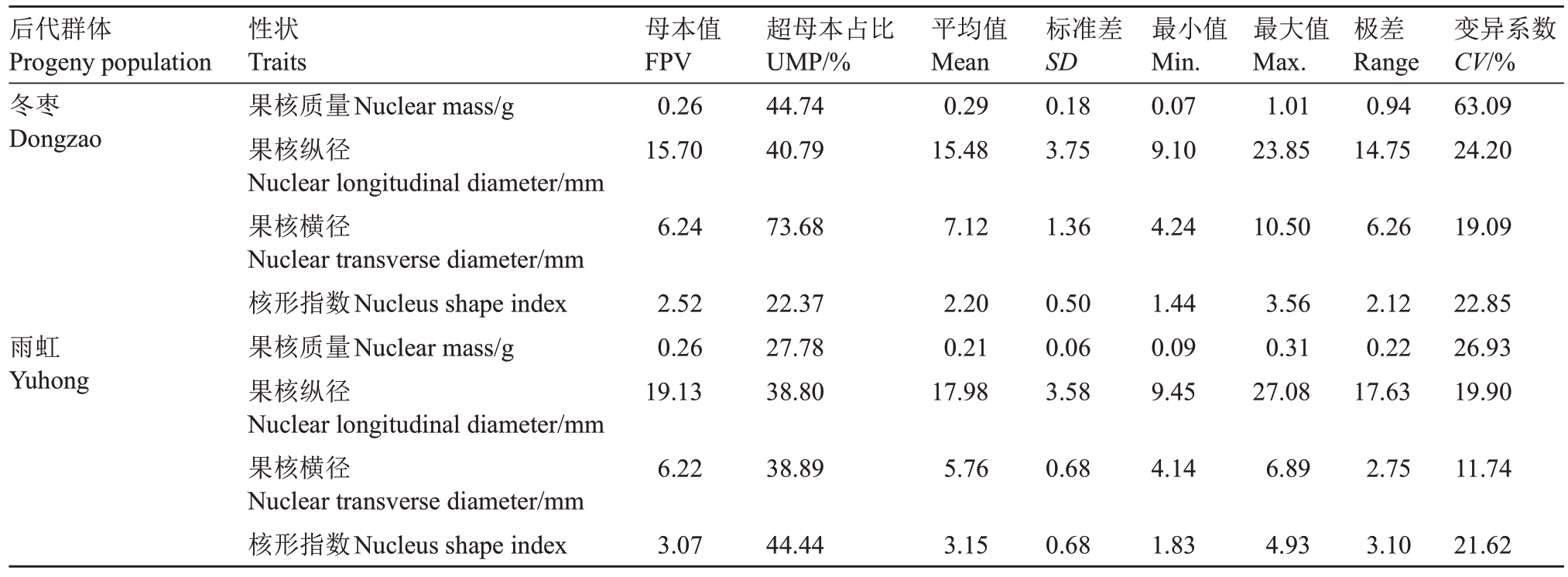
后代群体Progeny population冬枣Dongzao母本值FPV 0.26 15.70超母本占比UMP/%44.74 40.79性状Traits果核质量Nuclear mass/g果核纵径Nuclear longitudinal diameter/mm果核横径Nuclear transverse diameter/mm核形指数Nucleus shape index果核质量Nuclear mass/g果核纵径Nuclear longitudinal diameter/mm果核横径Nuclear transverse diameter/mm核形指数Nucleus shape index平均值Mean 0.29 15.48标准差SD 0.18 3.75最小值Min.0.07 9.10最大值Max.1.01 23.85极差Range 0.94 14.75变异系数CV/%63.09 24.20 6.2473.687.121.364.2410.506.2619.09雨虹Yuhong 2.52 0.26 19.13 22.37 27.78 38.80 2.20 0.21 17.98 0.50 0.06 3.58 1.44 0.09 9.45 3.56 0.31 27.08 2.12 0.22 17.63 22.85 26.93 19.90 6.2238.895.760.684.146.892.7511.74 3.0744.443.150.681.834.933.1021.62
2.4.2 果核大小性状的遗传分布情况 对果核大小进行正态性检验,结果(图3)表明冬枣、雨虹实生后代果核纵径、果核横径、核形指数符合正态分布,果核质量不符合正态分布。其中冬枣后代果核质量的正态拟合曲线上侧较长,数量点多集中在曲线下半部分,这表明后代群体果核质量、核形指数性状数值偏小的后代较多。
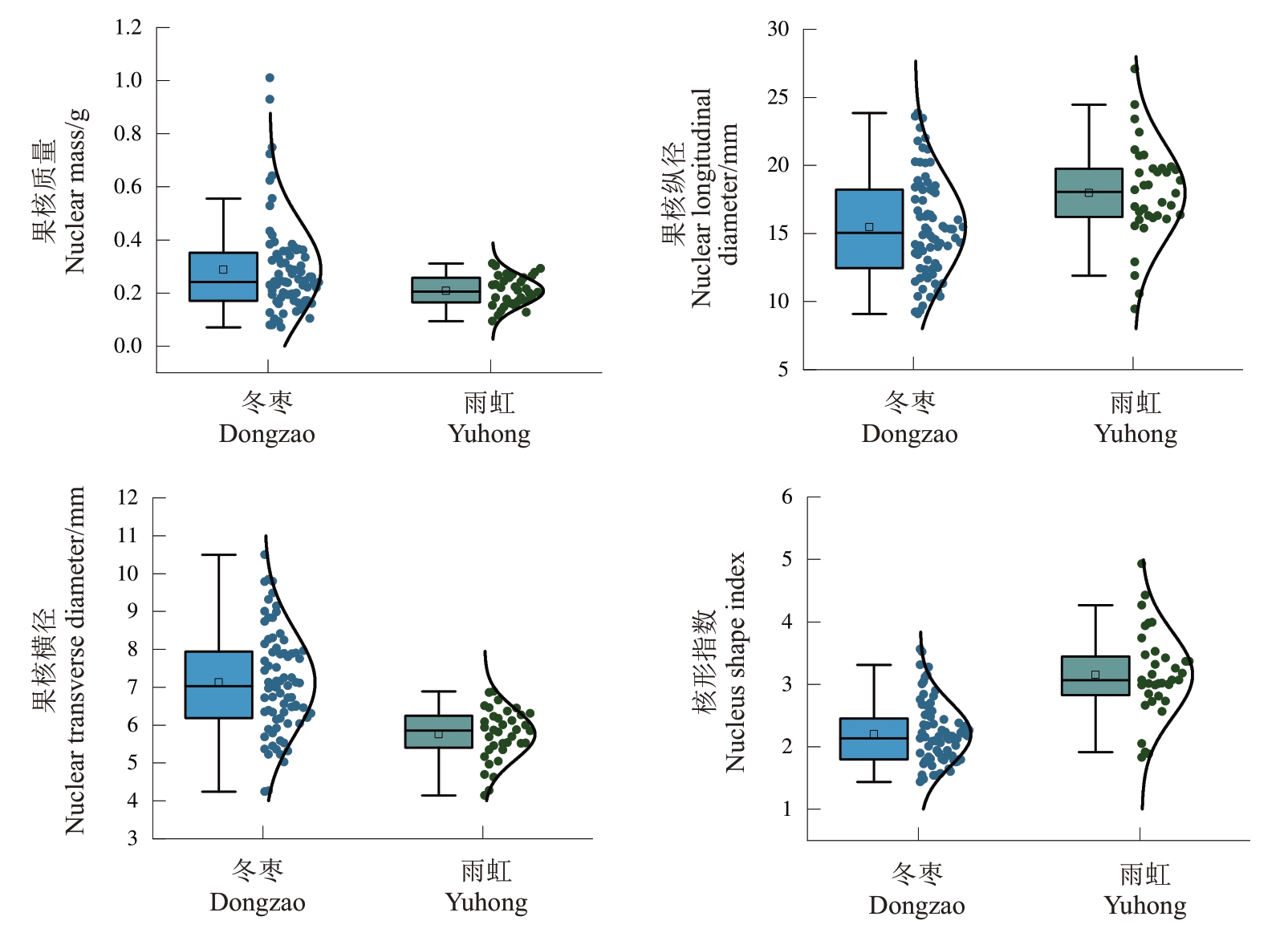
图3 果核性状的遗传分布
Fig.3 Genetic distribution of the kernel traits
2.5 果实成熟期、丰产性及抗性遗传变异分析
2.5.1 枣实生后代果实成熟期分离情况 对枣实生后代果实的成熟期进行调查,结果如表8所示,冬枣实生后代成熟期的分离类型为6种,其中在10月上旬成熟的居多,株数为24株,占比为31.58%;雨虹成熟期的分离类型为3种,其中10月中旬成熟的居多,株数为22株,占比为61.11%。
表8 枣实生后代果实成熟期的分离情况
Table 8 Separation of fruit maturity of jujube seedlings

后代群体Progeny population冬枣Dongzao雨虹Yuhong群体Population株数Number of stems占比Proportion/%株数Number of stems占比Proportion/%成熟期Ripening stageⅠ5ⅡⅢⅣⅤ9Ⅵ8 6.58 0 0.00 10 13.10 2 5.56 20 26.30 0 0.00 24 31.50 12 33.30 11.84 22 61.11 10.50 0 0.00
2.5.2 果实果吊比及抗裂果能力分离情况 对枣实生后代果吊比及抗裂果能力进行调查,结果如表9所示,冬枣、雨虹实生后代果吊比分离类型均为5种,其中冬枣后代果吊比在1 以上的后代株数为43株,占比为56.57%;雨虹后代为20 株,占比为55.56%;在抗裂果能力上,冬枣实生后代分离出5种类型,分离范围广,其后代裂果率在20.00%以下的株数为73 株,占比为96.06%;雨虹实生后代分离出3 种类型,其后代裂果率在20.00%以下的株数为35株,占比为97.22%。
表9 枣实生后代丰产性及抗裂能力的分离情况
Table 9 Separation of high yield and crack resistance of jujube seedling offspring

后代群体Progeny population冬枣Dongzao果吊比Fertility>2.0 16群体Population株数Number of stems占比Proportion/%株数Number of stems占比Proportion/%>1.5~2.0 9>1.0~1.5 18 0.5~1.0 21<0.5 12裂果率Fruit cracking rate/%0~5 67>5~10 5>10~20 1>20~50 2>50 1雨虹Yuhong 21.05 3 11.84 11 23.68 6 27.63 8 15.79 8 88.16 34 6.58 0 1.32 1 2.63 0 1.32 1 8.3330.5616.6722.2222.2294.440.002.780.002.78
2.6 优异种质筛选
2.6.1 优异鲜食种质筛选 对两个枣实生后代果实的综合口感、可滴定酸含量、单果质量、可溶性糖含量、果吊比、裂果率、维生素C含量等7个性状进行综合评定,通过最终的得分排名筛选出排名靠前综合能力突出的优株,并依据每个性状的实际需求和重要性分别给予不同程度的权重值,依次为0.25、0.1、0.2、0.15、0.1、0.1、0.1,依据加权关联度,初步选取了排名前13的后代为优异鲜食枣种质资源(表10)。其他性状表现如表11所示,13个优株口感评价均在75分以上,较为符合鲜食枣的口感需求,其成熟期在9月上旬的有2 株、9 月中旬的有4 株、9 月下旬的有3株、10 月上旬的有4 株,可溶性固形物含量均在35.93%以上,13株裂果率为0.00%,9株果吊比在1以上。
表10 枣实生后代鲜食枣综合评价
Table 10 Comprehensive evaluation of fresh jujube of jujube seedling offspring
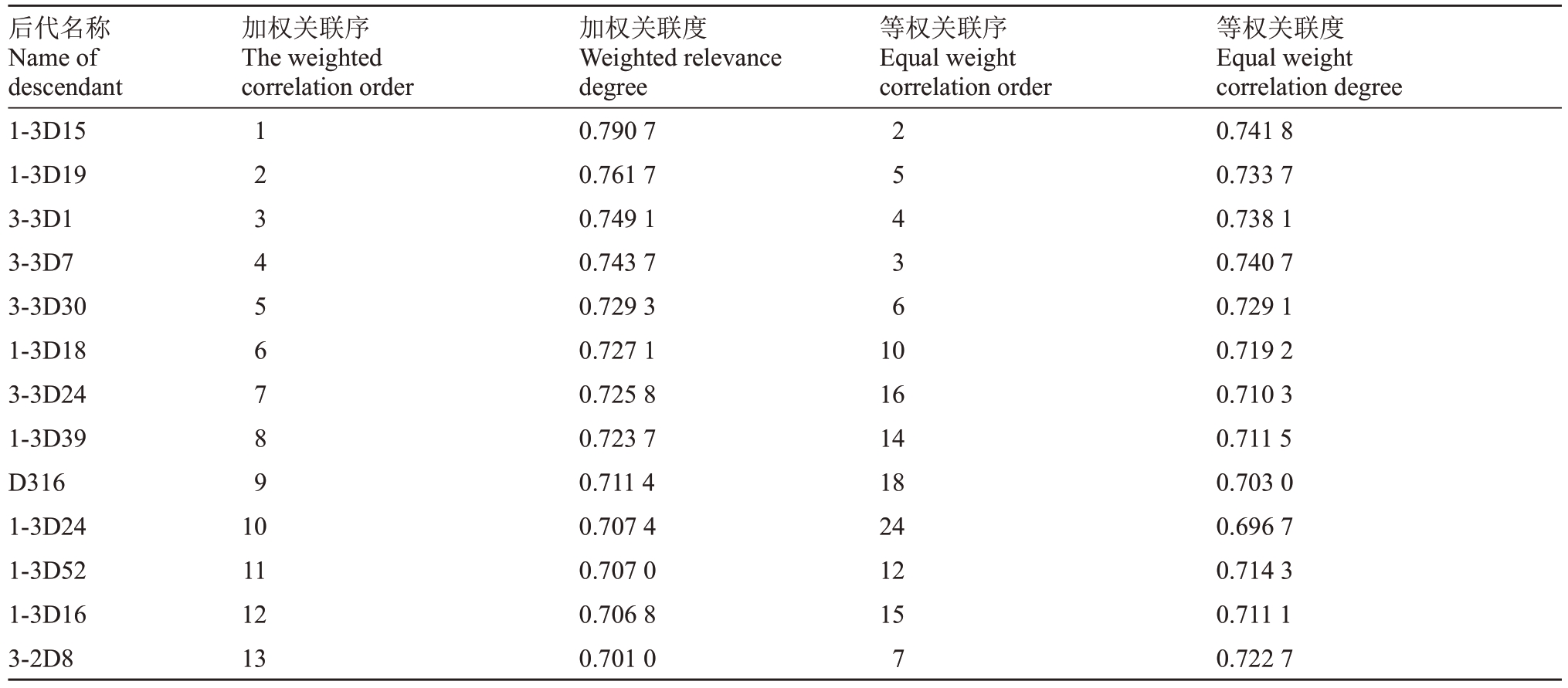
后代名称Name of descendant 1-3D15 1-3D19 3-3D1 3-3D7 3-3D30 1-3D18 3-3D24 1-3D39 D316 1-3D24 1-3D52 1-3D16 3-2D8加权关联序The weighted correlation order等权关联序Equal weight correlation order 123456789 25436 10 11 12 13加权关联度Weighted relevance degree 0.790 7 0.761 7 0.749 1 0.743 7 0.729 3 0.727 1 0.725 8 0.723 7 0.711 4 0.707 4 0.707 0 0.706 8 0.701 0 10 16 14 18 24 12 15 7等权关联度Equal weight correlation degree 0.741 8 0.733 7 0.738 1 0.740 7 0.729 1 0.719 2 0.710 3 0.711 5 0.703 0 0.696 7 0.714 3 0.711 1 0.722 7
表11 优异鲜食枣种质资源果实性状
Table 11 Fruit traits of excellent fresh jujube germplasm resources
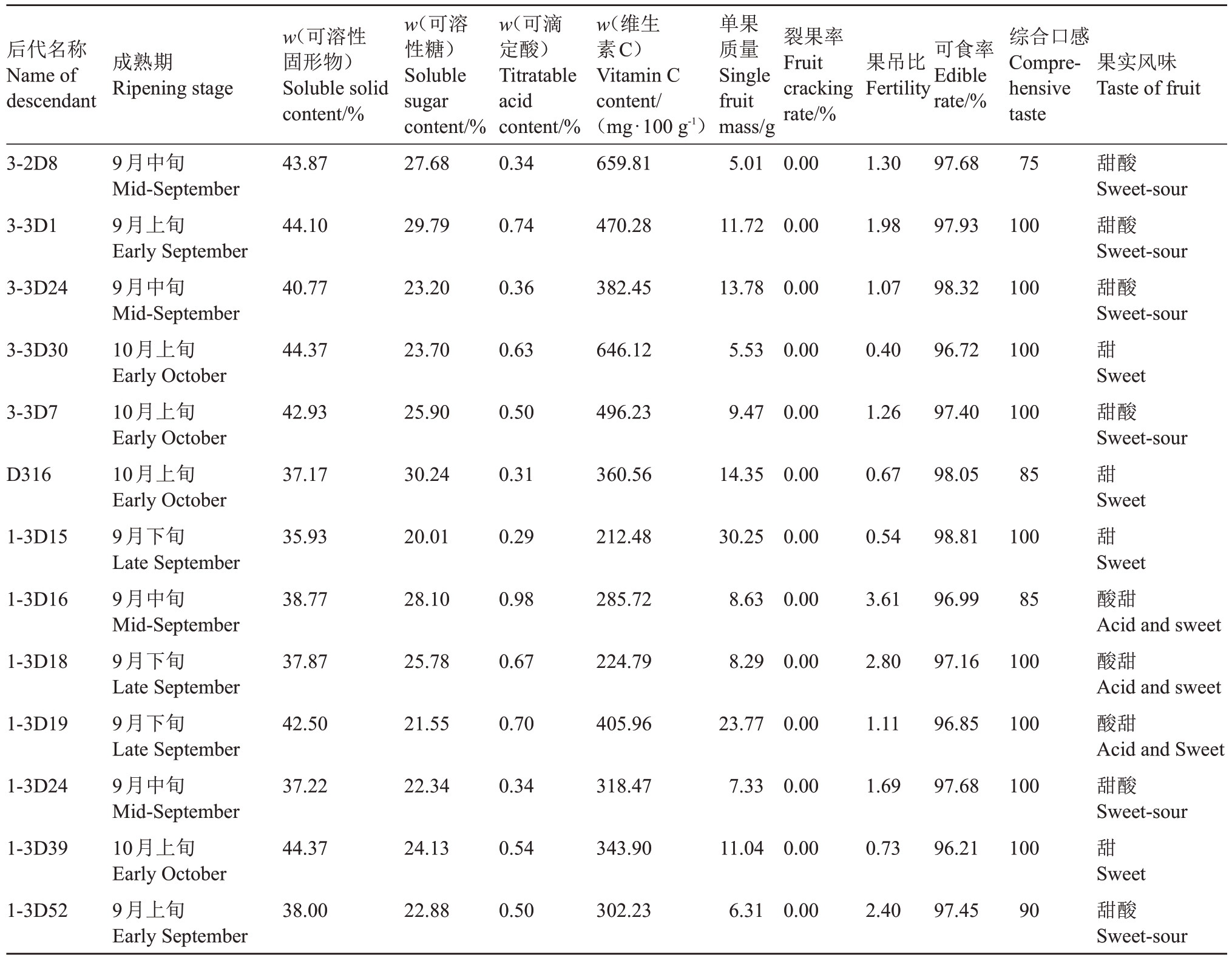
后代名称Name of descendant成熟期Ripening stage果吊比Fertility可食率Edible rate/%果实风味Taste of fruit 3-2D8 w(可溶性固形物)Soluble solid content/%43.87 w(可溶性糖)Soluble sugar content/%27.68 w(可滴定酸)Titratable acid content/%0.34 w(维生素C)Vitamin C content/(mg·100 g-1)659.81单果质量Single fruit mass/g 5.01裂果率Fruit cracking rate/%0.001.3097.68综合口感Comprehensive taste 75 3-3D144.1029.790.74470.2811.720.001.9897.93100 3-3D2440.7723.200.36382.4513.780.001.0798.32100 3-3D3044.3723.700.63646.125.530.000.4096.72100 3-3D742.9325.900.50496.239.470.001.2697.40100 D31637.1730.240.31360.5614.350.000.6798.0585 1-3D1535.9320.010.29212.4830.250.000.5498.81100 1-3D1638.7728.100.98285.728.630.003.6196.9985 1-3D1837.8725.780.67224.798.290.002.8097.16100 1-3D1942.5021.550.70405.9623.770.001.1196.85100 1-3D2437.2222.340.34318.477.330.001.6997.68100 1-3D3944.3724.130.54343.9011.040.000.7396.21100 1-3D52 9月中旬Mid-September 9月上旬Early September 9月中旬Mid-September 10月上旬Early October 10月上旬Early October 10月上旬Early October 9月下旬Late September 9月中旬Mid-September 9月下旬Late September 9月下旬Late September 9月中旬Mid-September 10月上旬Early October 9月上旬Early September 38.0022.880.50302.236.310.002.4097.4590甜酸Sweet-sour甜酸Sweet-sour甜酸Sweet-sour甜Sweet甜酸Sweet-sour甜Sweet甜Sweet酸甜Acid and sweet酸甜Acid and sweet酸甜Acid and Sweet甜酸Sweet-sour甜Sweet甜酸Sweet-sour
2.6.2 优异制干种质筛选 对雨虹实生后代果实的制干率、可滴定酸含量、单果质量、可溶性糖含量、裂果率、果吊比、果肉质地、果肉粗细、果皮厚度9个性状进行综合评价,初步筛选出制干性能较高的优株,并依据每个性状的实际需求和重要性分别给予不同程度的权重值,依次为0.20、0.05、0.15、0.10、0.1、0.1、0.1、0.1、0.1,依据加权关联度,初步选取了排名前5的后代为优异制干枣种质资源(表12)。其他性状表现如表13 所示,5 个优株制干率均在42.00%以上,拥有优异的抗裂果能力,果吊比均在0.92 以上,其中3-2M1、3-2M5、3-2M6 果皮厚度和果肉粗细均为满分。
表12 枣实生后代制干枣综合评价
Table 12 Comprehensive evaluation of dried jujube produced by jujube seedlings

后代名称Name of descendant 3-2M5 3-2M6 1-3M61 1-3M3 3-2M1加权关联序The weighted correlation order等权关联序Equal weight correlation order 12345加权关联度Weighted relevance degree 0.718 9 0.695 8 0.665 5 0.656 4 0.647 4 12963等权关联度Equal weight correlation degree 0.733 7 0.730 6 0.651 7 0.669 2 0.678 1
表13 优异制干枣种质资源果实性状
Table 13 Fruit traits of excellent dried jujube germplasm resources
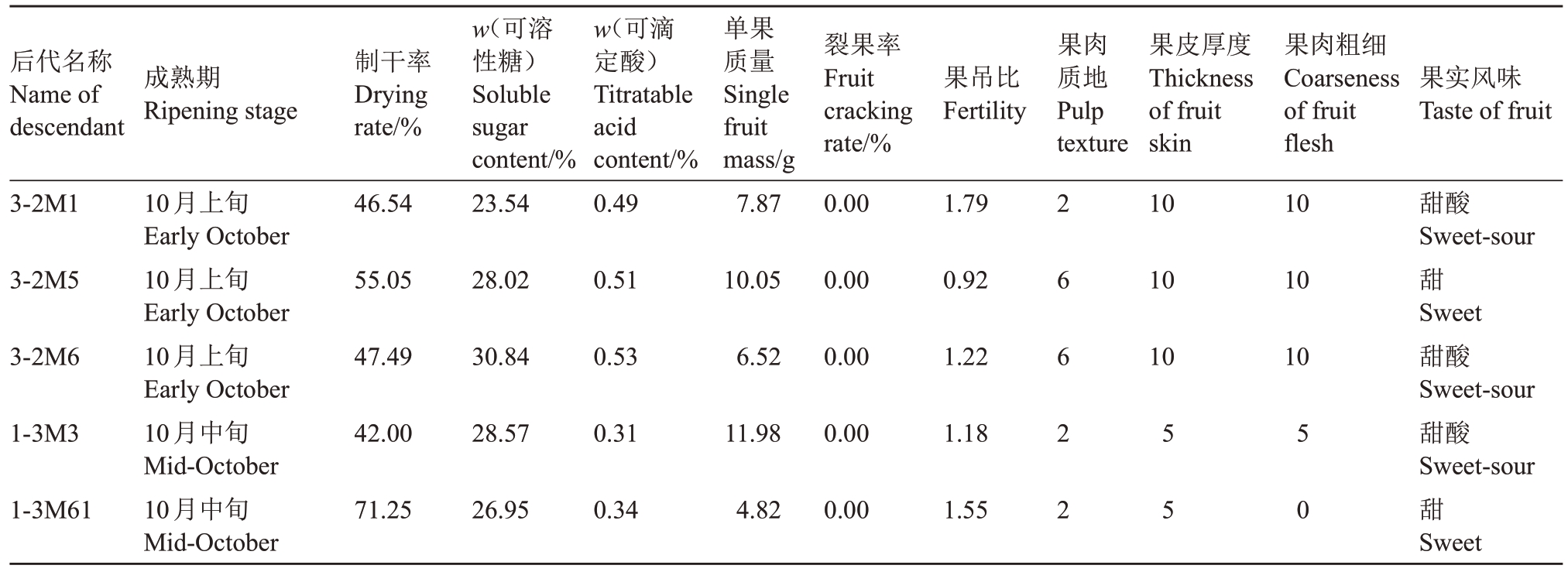
后代名称Name of descendant成熟期Ripening stage制干率Drying rate/%果吊比Fertility果肉质地Pulp texture果实风味Taste of fruit 3-2M146.54 w(可溶性糖)Soluble sugar content/%23.54 w(可滴定酸)Titratable acid content/%0.49单果质量Single fruit mass/g 7.87裂果率Fruit cracking rate/%0.001.79果皮厚度Thickness of fruit skin 10果肉粗细Coarseness of fruit flesh 10 3-2M555.0528.020.5110.050.000.921010 3-2M647.4930.840.536.520.001.221010 1-3M342.0028.570.3111.980.001.18 1-3M61 10月上旬Early October 10月上旬Early October 10月上旬Early October 10月中旬Mid-October 10月中旬Mid-October 71.2526.950.344.820.001.55 26622 55 50甜酸Sweet-sour甜Sweet甜酸Sweet-sour甜酸Sweet-sour甜Sweet
2.6.3 特色种质筛选 对于枣特色资源的筛选,筛选出可溶性总糖含量大于30.00%的高糖资源4 份,最高可达35.33%;其中冬枣后代2 份、雨虹后代2份。可滴定酸含量大于1.40%的高酸资源3份,最高可达1.68%;其中冬枣后代1 份、雨虹后代2 份。维生素C 含量大于591.00 mg·100 g-1的高维生素C 资源5 份,最高可达754.27 mg·100 g-1;均为冬枣后代。特色资源主要果实性状如表14所示。
表14 特色资源主要果实性状
Table 14 Main fruit traits of characteristic resources
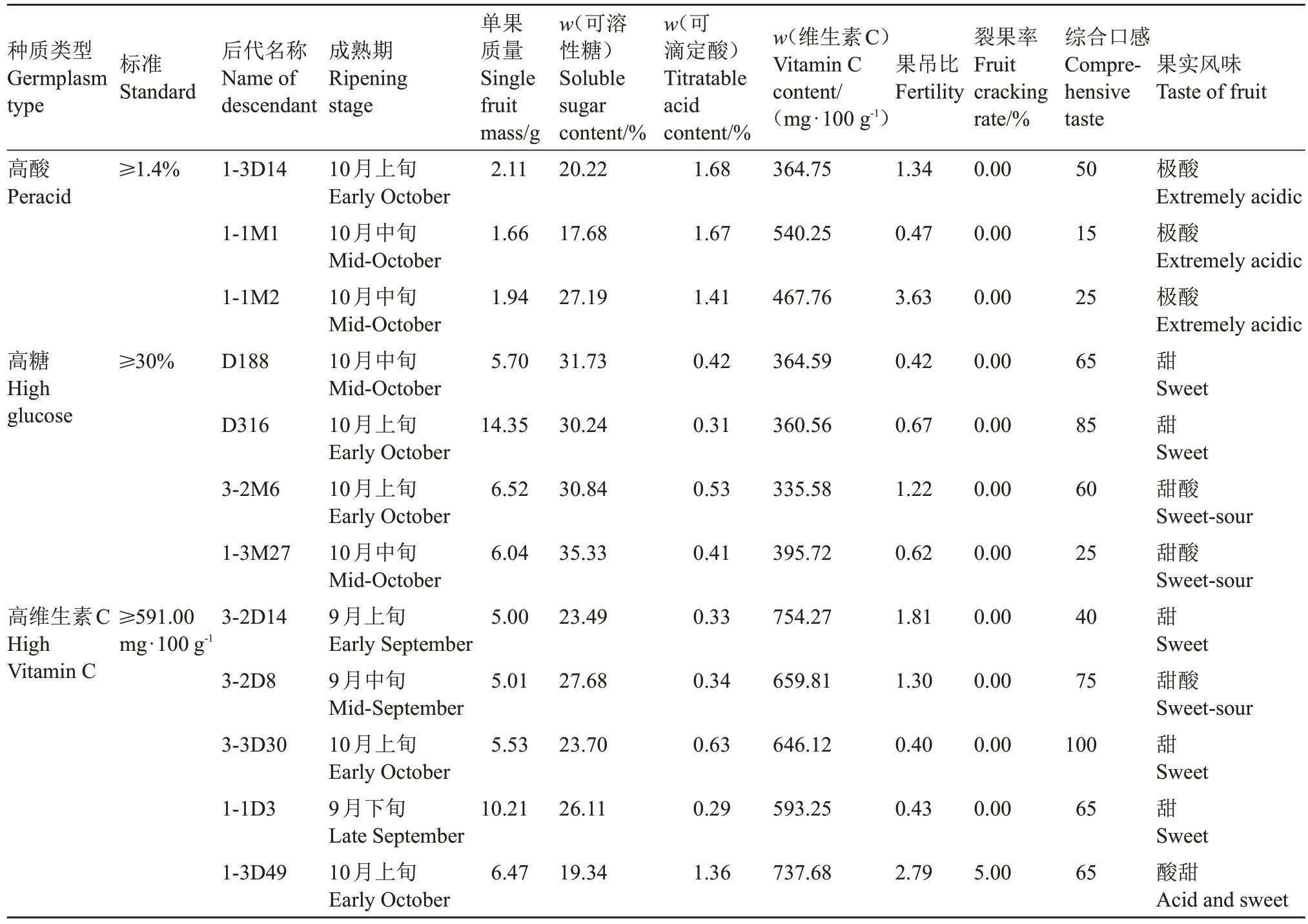
种质类型Germplasm type标准Standard后代名称Name of descendant成熟期Ripening stage果吊比Fertility果实风味Taste of fruit高酸Peracid≥1.4%1-3D14单果质量Single fruit mass/g 2.11 w(可溶性糖)Soluble sugar content/%20.22 w(可滴定酸)Titratable acid content/%1.68 w(维生素C)Vitamin C content/(mg·100 g-1)364.751.34裂果率Fruit cracking rate/%0.00综合口感Comprehensive taste 50 1-1M11.6617.681.67540.250.470.0015 1-1M21.9427.191.41467.763.630.0025高糖High glucose≥30%D1885.7031.730.42364.590.420.0065 D31614.3530.240.31360.560.670.0085 3-2M66.5230.840.53335.581.220.0060 1-3M276.0435.330.41395.720.620.0025高维生素C High Vitamin C≥591.00 mg·100 g-1 3-2D145.0023.490.33754.271.810.0040 3-2D85.0127.680.34659.811.300.0075 3-3D305.5323.700.63646.120.400.00100 1-1D310.2126.110.29593.250.430.0065 1-3D49 10月上旬Early October 10月中旬Mid-October 10月中旬Mid-October 10月中旬Mid-October 10月上旬Early October 10月上旬Early October 10月中旬Mid-October 9月上旬Early September 9月中旬Mid-September 10月上旬Early October 9月下旬Late September 10月上旬Early October 6.4719.341.36737.682.795.0065极酸Extremely acidic极酸Extremely acidic极酸Extremely acidic甜Sweet甜Sweet甜酸Sweet-sour甜酸Sweet-sour甜Sweet甜酸Sweet-sour甜Sweet甜Sweet酸甜Acid and sweet
3 讨 论
果实的外观和感官品质是决定果实经济价值的重要指标[28],对不同实生群体的果实外观及感官开展遗传变异比较及性状分析,有利于筛选果形优良、口感丰富的种质资源,为实生选种提供参考依据。笔者在本研究中发现,两个枣品种实生后代群体果实外观、感官等性状出现较大分离,17 个性状共分离出57个类型。冬枣是典型的圆形果实,后代果形出现7 种变异,与母本一致的圆形株系分别占9.21%,其中冬枣后代扁圆形株系最多(40.79%),雨虹果实是圆锥形,后代果形出现6种变异,长圆形株系最多(38.09%),可见两个品种实生后代果形变异较丰富。一般在鲜食枣选育中,常常将果肉的汁液量、粗细、质地等口感指标作为筛选优异鲜食枣的重要依据[29-31]。陆琦文[17]发现枣实生后代果肉粗细、汁液等性状有50%以上超过母本,出现丰富的变异。本研究中的试验材料冬枣是果实质地酥脆的鲜食品种,实生后代中果肉酥脆的株系分别占57.89%,薄果皮的株系分别占39.47%,表明冬枣后代在创制口感较好的鲜食枣种质方面更具优势。
果实大小是多基因控制的数量性状,存在明显的趋低遗传倾向[32-34]。对果实大小性状进行遗传变异分析和评价,探究不同实生群体的果实大小遗传变异特点,对大果型实生选种具有重要的指导意义。笔者在本研究中发现,两个枣实生后代群体果实大小、果核大小均出现广泛分离,冬枣实生后代单果质量超母本株系占比为34.21%,果实横径超母本株系占比为38.16%,最终呈现冬枣后代扁圆形株系较多,同时冬枣实生后代单果质量出现较为极端的变异株型,这进一步表明冬枣实生后代在果型种质的筛选方面更具潜力。李鹏丽[35]在枣实生后代研究中发现,果实的纵径、横径变异最大,变异系数分别为28.42%和21.39%,相比本研究中最高果实纵径、横径变异系数要低11.58 和12.82 百分点,这可能是实生群体不同所导致。两个实生后代群体可食率变异范围在0.89%~1.93%,变异程度相对较小,袁野等[15]在蜂蜜罐实生后代中可食率变异为0.05%,相比本研究中最低可食率变异要低0.84 百分点,这可能是不同授粉品种所影响的结果。两个群体比较,冬枣实生群体单果质量超亲率达34.21%,雨虹后代可溶性糖含量超亲率25.00%为最高。
实生后代株系杂合度较高,其果实内在品质性状会出现较为广泛的分离,这有利于特异性种质资源的筛选[36]。笔者在本研究中发现,两个枣品种群体实生后代内在品质变异范围在7.51%~75.33%之间,分离广泛,维生素C 是人体不可或缺的营养元素,可预防败血症,笔者在本研究中筛选出的5份高维生素C 资源含量均在593.25 mg·100 g-1以上,最高可达754.27 mg·100 g-1。相比董玉慧[27]248枣品种维生素C 平均含量为414.00 mg·100 g-1而言高出179.25 mg·100 g-1。高糖高酸的果实有利于加工口感丰富的特色果干和果汁,笔者在本研究中所获得的3 份高酸资源含量在1.41%以上,相比董玉慧[27]248枣品种最高可滴定酸1.02%高出0.39百分点,最高可达1.68%,所获得的7 份高糖资源含量在30.24%以上,相比董玉慧[27]248枣品种平均可溶性糖26.0%高出4.24 百分点,最高可达35.33%。综合分析,果实质地酥脆、汁液中等的种质可作为鲜食枣选育的候选材料,制干率高、果肉厚且口感软糯的种质可进一步挖掘制干优系,高糖、高酸、高维生素C 等特异优系可进一步为功能食品开发等深加工品种选育提供候选材料,从而加快枣新优特品种的选育进程。
4 结 论
枣两个品种实生后代群体果实性状出现丰富变异,40%左右后代果实与母本果形相似。冬枣实生后代果肉酥脆的株系占比高达57.89%,出现大果、扁圆形株系较多。两个群体可滴定酸含量、维生素C含量、黄酮含量超母本率超过57.89%,其中冬枣后代出现高果实维生素C含量和可滴定酸含量极端株系,56.58%以上的后代具备较强的抗裂果能力和较强的坐果能力。雨虹后代果实可溶性糖含量变异广泛,出现了可溶性固形物含量和高可滴定酸含量极端株系。初步筛选出综合性状优异的鲜食枣种质13份;综合性状优异的制干枣种质5份;特异种质12份,其中高糖种质4 份;高酸种质3 份;高维生素C 种质5份。
[1] 赵爱玲,李登科,王永康,隋串玲,曹彦清.枣品种资源的营养特性评价与种质筛选[J].植物遗传资源学报,2010,11(6):811-816.ZHAO Ailing,LI Dengke,WANG Yongkang,SUI Chuanling,CAO Yanqing. Evaluation on nutritious characteristics and germplasm screening of different Chinese jujube cultivars[J].Journal of Plant Genetic Resources,2010,11(6):811-816.
[2] 陈学森,郭文武,徐娟,丛佩华,王力荣,刘崇怀,李秀根,吴树敬,姚玉新,陈晓流.主要果树果实品质遗传改良与提升实践[J].中国农业科学,2015,48(17):3524-3540.CHEN Xuesen,GUO Wenwu,XU Juan,CONG Peihua,WANG Lirong,LIU Chonghuai,LI Xiugen,WU Shujing,YAO Yuxin,CHEN Xiaoliu. Genetic improvement and promotion of fruit quality of main fruit trees[J]. Scientia Agricultura Sinica,2015,48(17):3524-3540.
[3] YAN F F,WANG L H,ZHENG X J,LUO Z,WANG J R,LIU M J.Acquisition of triploid germplasms by controlled hybridisation between diploid and tetraploid in Chinese jujube[J]. The Journal of Horticultural Science and Biotechnology,2019,94(1):123-129.
[4] 纪晴,石倩倩,周军,胡孟豪,石卓功,段安安,和润喜.环剥与环割处理对冬枣生长结果及果实品质的影响[J].经济林研究,2016,34(4):80-85.JI Qing,SHI Qianqian,ZHOU Jun,HU Menghao,SHI Zhuogong,DUAN An’an,HE Runxi. Effects of girdling and ring cutting treatments on growth,fruiting and fruit quality of Dongzao[J].Nonwood Forest Research,2016,34(4):80-85.
[5] LUO Y J,CHEN W N,PAN Y L,GE L X,WU C Y,WANG J R,LIU M J,YAN F F. Comparison and genetic variation analysis of important fruit traits in jujube F1 hybrids by different male parents[J].Agronomy,2024,14(3):459.
[6] PAN Y L,LUO Y J,BAO J K,WU C Y,WANG J R,LIU M J,YAN F F. Screening candidate genes for fruit size based on QTL-seq in Chinese jujube[J].Frontiers in Plant Science,2024,15:1361771.
[7] 牛瑜菲,彭建营,李莉.枣及酸枣小孢子不同发育时期的花器形态与解剖特性研究[J].植物遗传资源学报,2011,12(1):158-162.NIU Yufei,PENG Jianying,LI Li. Morphology of flower organ and anatomical characteristics of microspore different developmental period in Chinese jujube and wild jujube[J]. Journal of Plant Genetic Resources,2011,12(1):158-162.
[8] 吴昊,苏万龙,石美娟,薛晓芳,任海燕,王永康,赵爱玲,李登科.枣种质果实性状多样性分析与综合评价[J].植物遗传资源学报,2022,23(6):1613-1625.WU Hao,SU Wanlong,SHI Meijuan,XUE Xiaofang,REN Haiyan,WANG Yongkang,ZHAO Ailing,LI Dengke. Diversity analysis and comprehensive evaluation of jujube fruit traits[J].Journal of Plant Genetic Resources,2022,23(6):1613-1625.
[9] 刘孟军,王玖瑞,刘平,赵锦,赵智慧,代丽,李宪松,刘志国.中国枣生产与科研成就及前沿进展[J].园艺学报,2015,42(9):1683-1698.LIU Mengjun,WANG Jiurui,LIU Ping,ZHAO Jin,ZHAO Zhihui,DAI Li,LI Xiansong,LIU Zhiguo. Historical achievements and frontier advances in the production and research of Chinese jujube (Ziziphus jujuba) in China[J].Acta Horticulturae Sinica,2015,42(9):1683-1698.
[10] 王玖瑞,刘玲,刘孟军,周俊义.枣树雄性不育新种质的获得[J].园艺学报,2006,33(2):374-377.WANG Jiurui,LIU Ling,LIU Mengjun,ZHOU Junyi.Acquirement of new male sterile germplasm of Chinese jujube[J].Acta Horticulturae Sinica,2006,33(2):374-377.
[11] 杨植,张川疆,杨芯芳,董梦怡,王振磊,闫芬芬,吴翠云,王玖瑞,刘孟军,林敏娟.枣与酸枣杂交后代果实遗传倾向及混合遗传分析[J].园艺学报,2023,50(1):36-52.YANG Zhi,ZHANG Chuanjiang,YANG Xinfang,DONG Mengyi,WANG Zhenlei,YAN Fenfen,WU Cuiyun,WANG Jiurui,LIU Mengjun,LIN Minjuan. Analysis of fruit genetic tendency and mixed inheritance in hybrid progeny of jujube and wild jujube[J].Acta Horticulturae Sinica,2023,50(1):36-52.
[12] 仇倩倩,冯一峰,吴翠云.枣种质资源叶表型性状遗传多样性分析[J].新疆农业科学,2021,58(2):282-293.QIU Qianqian,FENG Yifeng,WU Cuiyun. Genetic diversity of leaf phenotypic traits in jujube germplasm resources[J].Xinjiang Agricultural Sciences,2021,58(2):282-293.
[13] 潘依玲,鲍荆凯,陈万年,吴翠云,王玖瑞,刘孟军,闫芬芬.枣JMS2×交城5 号F1代果实性状遗传分析与优系筛选[J].果树学报,2023,40(6):1085-1098.PAN Yiling,BAO Jingkai,CHEN Wannian,WU Cuiyun,WANG Jiurui,LIU Mengjun,YAN Fenfen. Genetic analysis of fruit traits and selection of superior lines in F1 generation of jujube JMS2 × Jiaocheng 5[J]. Journal of Fruit Science,2023,40(6):1085-1098.
[14] 陈万年,鲍荆凯,潘依玲,吴翠云,王玖瑞,刘孟军,闫芬芬.枣JMS2×交城5 号F1代糖酸组分遗传变异分析[J].植物遗传资源学报,2023,24(3):767-779.CHEN Wannian,BAO Jingkai,PAN Yiling,WU Cuiyun,WANG Jiurui,LIU Mengjun,YAN Fenfen. Genetic variation analysis of sugar-acid fraction in F1 hybrids of jujube JMS2 ×Jiaocheng 5[J].Journal of Plant Genetic Resources,2023,24(3):767-779.
[15] 袁野,胡兰,刘平,刘孟军.‘蜂蜜罐’枣实生后代果实性状变异分析与评价[J].植物遗传资源学报,2018,19(3):539-545.YUAN Ye,HU Lan,LIU Ping,LIU Mengjun. Evaluation of fruit character in naturally-pollinated progeny of Ziziphus jujuba Mill.‘Fengmiguan’[J]. Journal of Plant Genetic Resources,2018,19(3):539-545.
[16] 申才蕊,林敏娟,吴翠云,郝庆.16 株枣实生优株生物学特性比较及其果实品质评价[J].经济林研究,2023,41(2):171-181.SHEN Cairui,LIN Minjuan,WU Cuiyun,HAO Qing. Comparison of biological characteristics of 16 superior jujube seedlings and evaluation of fruit quality[J]. Non-wood Forest Research,2023,41(2):171-181.
[17] 陆琦文.枣实生后代主要性状遗传变异分析及优异种质筛选[D].阿拉尔:塔里木大学,2020.LU Qiwen. Genetic variation analysis of main traits and excellent germplasm screening of jujube seedlings[D]. Alar:Tarim University,2020.
[18] 牛迎凤,李开雄,刘紫艳,郑诚,孔广红,柳觐.云南芒果栽培种质资源花性状的变异分析[J].热带农业科技,2018,41(2):12-17.NIU Yingfeng,LI Kaixiong,LIU Ziyan,ZHENG Cheng,KONG Guanghong,LIU Jin.Analysis of floral properties variation of cultivated mango (Mangifera indica L.) germplasm in Yunnan Province[J]. Tropical Agricultural Science & Technology,2018,41(2):12-17.
[19] 刘孟军,汪民.中国枣种质资源[M].北京:中国林业出版社,2009.LIU Mengjun,WANG Min.Germplasm resources of Chinese jujube[M].Beijing:China Forestry Publishing House,2009.
[20] 段开行,王晓玲,毛永民,王瑶,任勇响,任柳柳,申连英.酸枣种质资源果实数量性状遗传多样性分析[J].园艺学报,2023,50(12):2568-2576.DUAN Kaihang,WANG Xiaoling,MAO Yongmin,WANG Yao,REN Yongxiang,REN Liuliu,SHEN Lianying.Analysis of genetic diversity of wild jujube germplasm resources based on quantitative characters[J]. Acta Horticulturae Sinica,2023,50(12):2568-2576.
[21] 李登科.枣种质资源描述规范和数据标准[M].北京:中国农业出版社,2006.LI Dengke.Descriptors and data standard for jujube(Ziziphus jujuba Mill.)[M].Beijing:China Agriculture Press,2006.
[22] 高俊凤. 植物生理学实验指导[M]. 北京:高等教育出版社,2006:144-199.GAO Junfeng. Experimental guidance for plant physiology[M].Beijing:Higher Education Press,2006:144-199.
[23] 李军.钼蓝比色法测定还原型维生素C[J].食品科学,2000,21(8):42-45.LI Jun. Molybdenum blue colorimetric method for the determination of reduced vitamin C[J]. Food Science,2000,21(8):42-45.
[24] 夏怡蕾,仇倩倩,杨植,鲍荆凯,闫芬芬,王玖瑞,吴翠云,刘孟军. 枣果实总黄酮和总酚含量性状的QTL 定位分析[J/OL].分子植物育种,2022:1-16. (2022-05-06). https://kns.cnki.net/kcms/detail/46.1068.S.20220505.1649.024.html.XIAYilei,QIU Qianqian,YANG Zhi,BAO Jingkai,YAN Fenfen,WANG Jiurui,WU Cuiyun,LIU Mengjun. The QTL mapping analysis of fruit total flavonoids and phenols in jujube[J/OL].Molecular Plant Breeding,2022:1-16.(2022-05-06).https://kns.cnki.net/kcms/detail/46.1068.S.20220505.1649.024.html.
[25] 刘隋赟昊,李建贵,韩超,杨文英,于婷,王娜.30 个制干枣品种在新疆库尔勒地区的引种[J].经济林研究,2016,34(3):90-98.LIU Suiyunhao,LI Jiangui,HAN Chao,YANG Wenying,YU Ting,WANG Na.Introduced performances of 30 Chinese jujube cultivars in Korla of Xinjiang[J]. Nonwood Forest Research,2016,34(3):90-98.
[26] 樊保国,李月梅,李登科,杜学梅.晋西沿黄枣区新引入制干品种的试验研究[J].西北林学院学报,2018,33(6):127-132.FAN Baoguo,LI Yuemei,LI Dengke,DU Xuemei.Experimental study on newly introduced dried-jujube varieties to the jujube cultivation region of western Shanxi along the Yellow River[J].Journal of Northwest Forestry University,2018,33(6):127-132.
[27] 董玉慧.枣树农艺性状遗传多样性评价与核心种质构建[D].保定:河北农业大学,2008:68-70.DONG Yuhui. Evaluation on genetic diversity of agronomic characters and core collection construction in Ziziphus jujuba Mill.[D].Baoding:Hebei Agricultural University,2008:68-70.
[28] 张军科,李兴亮,李民吉,周贝贝,张强,魏钦平.影响消费者对‘富士’苹果品质主观评价的因素分析及评价模型建立[J].果树学报,2017,34(10):1316-1322.ZHANG Junke,LI Xingliang,LI Minji,ZHOU Beibei,ZHANG Qiang,WEI Qinping.Factors involved in the consumer’s sensorial evaluation of fruit quality and the construction of the subjective evaluation models of the‘Fuji’apple[J]. Journal of Fruit Science,2017,34(10):1316-1322.
[29] 单公华,沈广宁,张琼,周广芳,王长贵,刘庆莲.制干鲜食兼用枣新品种鲁枣5 号的选育[J]. 果树学报,2012,29(1):151-152.SHAN Gonghua,SHEN Guangning,ZHANG Qiong,ZHOU Guangfang,WANG Changgui,LIU Qinglian. A new dry and fresh Chinese jujube cultivar:Luzao 5[J]. Journal of Fruit Science,2012,29(1):151-152.
[30] 单公华,周广芳,张琼,沈广宁,余贤美,徐颖.枣新品种‘鲁枣4 号’[J].园艺学报,2011,38(5):1007-1008.SHAN Gonghua,ZHOU Guangfang,ZHANG Qiong,SHEN Guangning,YU Xianmei,XU Ying.A new Chinese jujube cultivar‘Luzao 4’[J].Acta Horticulturae Sinica,2011,38(5):1007-1008.
[31] 单公华,周广芳,张琼,沈广宁,余贤美,徐颖,田寿乐,刘嘉芬,王中堂.晚熟鲜食枣新品种‘鲁枣6 号’[J].园艺学报,2012,39(7):1409-1410.SHAN Gonghua,ZHOU Guangfang,ZHANG Qiong,SHEN Guangning,YU Xianmei,XU Ying,TIAN Shoule,LIU Jiafen,WANG Zhongtang.A new Chinese jujube cultivar‘Luzao 6’[J].Acta Horticulturae Sinica,2012,39(7):1409-1410.
[32] 刘有春,李嘉琦,刘成.越橘果实大小遗传规律及其与花冠、叶面积的相关性研究[J].果树学报,2023,40(10):2050-2060.LIU Youchun,LI Jiaqi,LIU Cheng. Investigation on inheritance of fruit size and its correlation with corolla and leaf area in blueberry (Vaccinium)[J]. Journal of Fruit Science,2023,40(10):2050-2060.
[33] 孙伟,高庆玉.中国李自然杂交后代抗寒力、果实大小的遗传与变异[J].东北农业大学学报,2003,34(3):250-253.SUN Wei,GAO Qingyu. Inheritance of cold hardiness and fruit size in Chinese plum (Prunus salicina Lindl.)[J]. Journal of Northeast Agricultural University,2003,34(3):250-253.
[34] 黄爱萍,邓朝军,陈秀萍,蒋际谋,李韬,姜帆,郑少泉.龙眼杂交后代果实性状遗传变异研究[J]. 福建农业学报,2006,21(4):342-345.HUANG Aiping,DENG Chaojun,CHEN Xiuping,JIANG Jimou,LI Tao,JIANG Fan,ZHENG Shaoquan. Study on the genetic variation of the fruit traits of longan filial generation[J].Fujian Journal of Agricultural Sciences,2006,21(4):342-345.
[35] 李鹏丽.枣实生后代主要性状遗传变异规律的研究[D].保定:河北农业大学,2003.LI Pengli.Study on trait separation of Chinese jujube seedlings[D].Baoding:Hebei Agricultural University,2003.
[36] 冀晓昊,张芮,毛志泉,匡林光,鹿明芳,王燕,张艳敏,陈学森.野生樱桃李实生后代果实性状变异分析及优异种质挖掘[J].园艺学报,2012,39(8):1551-1558.JI Xiaohao,ZHANG Rui,MAO Zhiquan,KUANG Linguang,LU Mingfang,WANG Yan,ZHANG Yanmin,CHEN Xuesen.The analysis of characteristic variations of the seedlings of Xinjiang wild myrobalan plum and excavation of the excellent germplasm resources[J].Acta Horticulturae Sinica,2012,39(8):1551-1558.